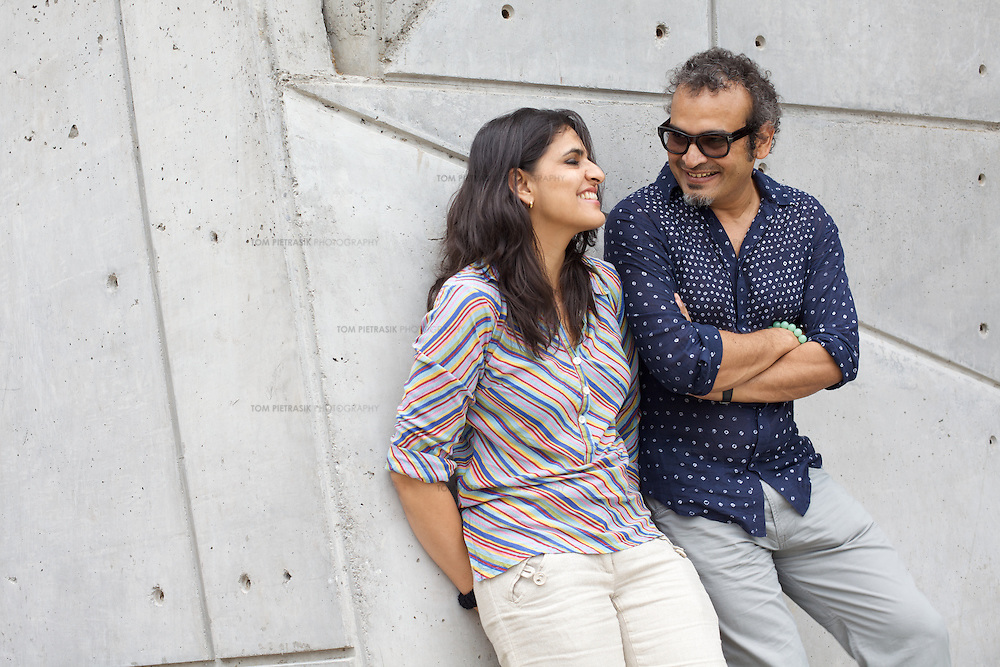Saptarshi Ghosh
We do compete healthily or unhealthily, sometimes
Bharti Kher
Valentine’s Day is a day of love. Whether it is positive affirmations, flowers, or chocolates, partners all around the world show appreciation to their significant others on this day. The day makes us aware of the transformative power of love. Today, at AbirPothi, we bring to you the story of an artist couple who have genuinely bewitched us, not just because of their individual and widely commended art careers, but with their meet-cute story which progressed into a story of the ages.
Let’s take a brief walkthrough of their art careers!
Bharti Kher
Kher migrated to India in the early 1990s. Owing to her upbringing and education in the United Kingdom, Kher’s initial perspective as an artist was that of an outsider. She was influenced by the changing landscape of India, owing to economic liberalisation and the rise of sectarian and communal forces. Initially, her works incorporated objects loaded with cultural significance in the Indian context and poked fun at patriarchal customs and superstitions prevailing in society.
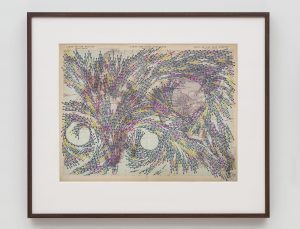
Image courtesy: Bharti Kher
Kher used the bindi for the first time in her 1996 work Spit and Swallow. Comprising two panels, the work featured sperm-shaped bindis, which radiated in opposite directions in each of the panels. The decision to use bindis came about when Kher encountered women wearing them in the markets of Delhi. Kher believes that the bindi is “meant to represent a third eye – one that forges a link between the real and the spiritual-conceptual worlds”. It must be noted that Kher uses the bindi as a material, much like paint or clay, but with an inherent narrative. Some other works of Kher featuring bindis are Formless Connections (2016), Dark Matter MM (2015), Splitting the Atom (2015) and Future is not fixed (2020).
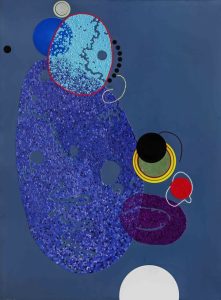
Image courtesy: Bharti Kher
Integral to Kher’s oeuvre are her sculptural works, which include fantastical hybrid creatures, blurring the distinction between the human and nature. The animal-human hybrid figure in Arione (2004) is depicted as a dominatrix serving muffins on a tray upon which her breasts rest, voicing repressed feminine fantasies. In her sculpture, Kher often references magical beasts, mythical monsters and allegorical tales. In An Absence of an Assignable Cause (2007), she recreates the enormous heart of a whale using fibreglass, with its veins and arteries protruding. She uses found objects in her works, which she surveys, collects and transforms to initiate a dialogue between the metaphysical and the mystical.
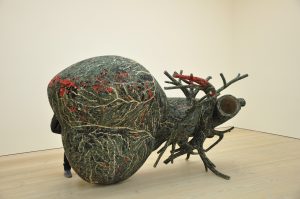
Image courtesy: Wikimedia Commons
Kher’s works were recently on display at the Arnolfini Gallery in Bristol, UK as part of her solo show The Body is A Place.
Subodh Gupta
By incorporating objects commonly used in Indian kitchens and households, like steel utensils, tiffin boxes, bicycles and milk pails, Gupta produces breathtaking sculptures that reflect the anxieties of a nation experiencing radical economic transformation with every passing year. He harnesses the ambiguous connotations these objects evoke in his varied audience – to an unversed Western audience, they appear exotic, whereas, to Indian viewers, they are ordinary objects part of their daily lives. Gupta uses such mass-produced objects to explore the ambivalence in a society torn between globalisation and traditional customs.
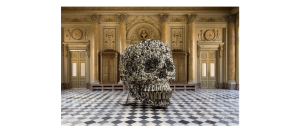
Image courtesy: Artsy
Steel utensils occur in Gupta’s works in various ways. In A Glass of Water (2011), they are shown to serve their usual utility, whereas in Very Hungry God (2006), they accumulate to produce composite structures – in this case, a large, glittering human skull; the work Ray (2012) on the other hand features a giant steel bucket suspended in the air, which pours out a stream of smaller buckets. The inspiration to use steel utensils came to Gupta one day in 1996, when he was on the lookout for new materials to work with and found himself in front of the utensils rack in his kitchen. The first such work that came about was The Way Home I, which was displayed at Chemould Gallery, Mumbai, in 1999. It consists of multiple stainless steel utensils strewn across the floor in no particular order. These utensils symbolise the domestic sphere. However, mingled with these utensils are kattas or country-manufactured guns, which again draw attention to the prevalence of crime and violence in daily life in Bihar.
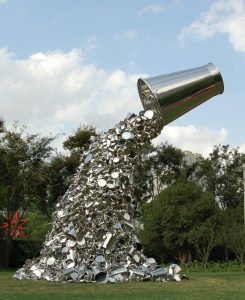
Image courtesy: Nature Morte
In Silk Route (2007), Gupta stacked countless stainless steel tiffin boxes in towers, underlining issues of commodification and cancerous proliferation in today’s age of mass-produced goods. His work Cow (2005) comprises a cast-bronze bicycle with shiny aluminium buckets hanging from it – the work is meant to embody how the bicycle supplants the role of the cow in a city, in that milk is individually delivered by milkmen on bicycles. “Buckets are very resonant to me,” explains Gupta. “Where I grew up, big families lived together, and taking the bucket meant you were going to bathe. It’s all creating a juxtaposition between the personal and something bigger.” Many of Gupta’s works also include kitchen racks along with utensils, like Take Off Your Shoes and Wash Your Hands (2008) and Family Nest No. 2 (2012). Gupta’s practice is similar to Marcel Duchamp’s use of readymade objects, as pointed out by Sania Galundi in an illuminating essay: “Gupta adopts the idea of displacement of the readymade popularised by the artist Marcel Duchamp in the early 20th century. Gupta’s artworks often comprise objects displaced from their original context and functional use and displayed in a different context.”
Their Meet-Cute
Kher met Gupta on a brief trip to New Delhi in 1992, following her art education. They fell in love and soon got married in 1993. Both decided to settle in India itself. Needless to say, they consider each other to be the most crucial factor behind their artistic success. “We do compete, healthily or unhealthily, sometimes,” Kher had said in an interview. “I think the crux of our relationship is art because this is something we are both extremely passionate about.” We at Abir Pothi wish Kher and Gupta a very happy Valentine’s Day!
Image Courtesy – Tom Pietrasik Video & Photography
Capturing Eternal Love: Exploring Shiv Parvati Art in Paintings and Drawings

